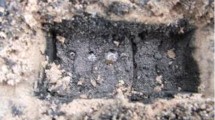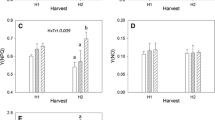Abstract
Pines, used for sand dune stabilization, can influence the hydrophysical parameters and water flow in an aeolian sandy soil considerably, mainly due to soil water repellency. Two sites, separated by distance of about 20 m, formed the basis of our study. A control soil (“Pure sand“) with limited impact of vegetation or organic matter was formed at 50 cm depth beneath a forest glade area. This was compared to a “Forest soil” in a 30-year old Scots pine (Pinus sylvestris) forest. Most of the hydrophysical parameters were substantially different between the two soil surfaces. The forest soil was substantially more water repellent and had two-times the degree of preferential flow compared to pure sand. Water and ethanol sorptivities, hydraulic conductivity, and saturated hydraulic conductivity were 1%, 84%, 2% and 26% those of the pure sand, respectively. The change in soil hydrophysical parameters due to soil water repellency resulted in preferential flow in the forest soil, emerging during a simulated heavy rain following a long hot, dry period. The wetting front established in pure sand exhibited a form typical of that for stable flow. Such a shape of the wetting front can be expected in the forest soil in spring, when soil water repellency is alleviated substantially.
Similar content being viewed by others
References
Beatty S.M. & Smith J.E. 2013. Dynamic soil water repellency and infiltration in post-wildfire soils. Geoderma 192: 160–172.
Buczko U., Bens O. & Hüttl R.F. 2006. Water infiltration and hydrophobicity in forest soils of a pine-beech transformation chronosequence. J. Hydrol. 331: 383–395.
CAB International 2002. Pines of Silvicultural Importance. CABI Publishing, Wallingford.
Decagon 2007. Minidisk Infiltrometer User’s Manual. Decagon Devices, Inc., Pullman.
Doerr S.H., Shakesby R.A. & Walsh R.P.D. 2000. Soil water repellency: its causes, characteristics and hydro-geomorphological significance. Earth-Sci. Rev. 51: 33–65.
García F.J.M., Dekker L.W., Oostindie K. & Ritsema C.J. 2005. Water repellency under natural conditions in sandy soils of southern Spain. Aust. J. Soil Res. 43: 291–296.
Hallett P.D., Baumgartl T. & Young I.M. 2001. Subcritical water repellency of aggregates from a range of soil management practices. Soil Sci. Soc. Am. J. 65: 184–190.
Homolák M., Capuliak J., Pichler V. & Lichner Ľ. 2009. Estimating hydraulic conductivity of a sandy soil under different plant covers using minidisk infiltrometer and a dye tracer experiment. Biologia 64: 600–604.
Kutílek M. & Krejča M. 1987. Three-parameter infiltration equation of Philip type (in Czech). Vodohosp. Čas. 35: 52–61.
Kutílek M. & Nielsen D.R. 1994. Soil Hydrology. Catena, Cremlingen-Destedt, 370 pp.
Lamparter A., Bachmann J. & Woche S.K. 2010. Determination of small-scale spatial heterogeneity of water repellency in sandy soils. Soil Sci. Soc. Am. J. 74: 2010–2012.
Levene H. 1960. Robust tests for equality of variances, pp. 278–292. In: Olkin, I. et al. (eds), Contributions to Probability and Statistics. Stanford University Press, Palo Alto.
Lichner L., Hallett P.D., Orfánus T., Czachor H., Rajkai K., Šír M. & Tesař M. 2010. Vegetation impact on the hydrology of an aeolian sandy soil in a continental climate. Ecohydrol. 3: 413–420.
Lichner L., Eldridge D.J., Schacht K., Zhukova N., Holko L., Šír M. & Pecho J. 2011. Grass cover influences hydrophysical parameters and heterogeneity of water flow in a sandy soil. Pedosphere 21: 719–729.
Lichner L., Holko L., Zhukova N., Schacht K., Rajkai K., Fodor N. & Sándor R. 2012. Plants and biological soil crust influence the hydrophysical parameters and water flow in an aeolian sandy soil. J. Hydrol. Hydromech. 60: 309–318.
Müller K. & Deurer M. 2011. Review of the remediation strategies for soil water repellency. Agric. Ecosyst. Environ. 144: 208–221.
Pekárová P., Svoboda A., Miklánek P., Škoda P., Halmová D. & Pekár J. 2012. Estimating flash flood peak discharge in Gidra and Parná basin: case study for the 7–8 June 2011 flood. J. Hydrol. Hydromech. 60: 206–216.
Soil Survey Division Staff 1993. Soil survey manual. Soil Conservation Service. U.S. Department of Agriculture Handbook 18, 437 pp.
Täumer K., Stoffregen H. & Wessolek G. 2006. Seasonal dynamics of preferential flow in a water repellent soil. Vadose Zone J. 5: 405–411.
Wessolek G., Schwärzel K., Greiffenhagen A. & Stoffregen H. 2008. Percolation characteristics of a water-repellent sandy forest soil. Eur. J. Soil Sci. 59: 14–23.
Wine M.L., Ochsner T.E., Sutradhar A. & Pepin R. 2012. Effects of eastern redcedar encroachment on soil hydraulic properties along Oklahoma’s grassland-forest ecotone. Hydrol. Process. 26: 1720–1728.
WRB 2006. World Reference Base for Soil Resources 2006. 2nd edition. World Soil Resources Reports No. 103. FAO, Rome.
Zhang R. 1997. Determination of soil sorptivity and hydraulic conductivity from the disk infiltrometer. Soil Sci. Soc. Am. J. 61: 1024–1030.
Author information
Authors and Affiliations
Corresponding author
Additional information
Special Section on Biohydrology, guest-editors Ľubomír Lichner & Kálmán Rajkai
Rights and permissions
About this article
Cite this article
Lichner, Ľ., Capuliak, J., Zhukova, N. et al. Pines influence hydrophysical parameters and water flow in a sandy soil. Biologia 68, 1104–1108 (2013). https://doi.org/10.2478/s11756-013-0254-7
Received:
Accepted:
Published:
Issue Date:
DOI: https://doi.org/10.2478/s11756-013-0254-7




